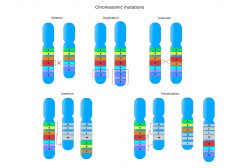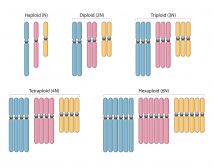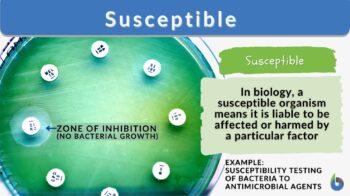
Susceptible
adj., [səˈsɛptɪbl̩]
Definition: at risk or liable to something
Table of Contents
Resistance, vulnerability, sensitivity, tolerance, and susceptibility are some highly important terminologies across the various subjects of biology.
Whether you use these terms in the sense of quality (as stated above) or their derived terms as an adjective like resistant, vulnerable, sensitive, tolerant, or susceptible respectively, they find wide usages. From their common usage in microbiology, pathology, and ecology to less frequent usage in cell biology, molecular biology, and other related fields, we have often encountered these terms many times.
The word of the day and the topic of today’s discussion revolves around the term “susceptible”. We would like to dissect the term to a limit where you gain clarity about not just the term but also its biological essence and utility. So let’s move ahead and learn what susceptible means in biology and how one should define susceptible and use the term.
Susceptible Definition
Susceptible Meaning: The word susceptible means the capability to admit anything additional, or any change, affection, or influence. An object or entity is labeled susceptible to change when it’s readily acted upon by some force of nature, person, or action.
In the general sense, a susceptible person is an easily influenced person; someone who can easily be caught in a situation or disguised under an impression. That is the reason, young children are considered more susceptible than adults. They can easily be affected emotionally. Susceptible individuals in the common language carry more probability of getting influenced, whether it be in a positive or negative way.
Etymology of Susceptible
The origin of the word susceptible is from the Late Latin word ‘susceptibilis’ that has further been taken from an older Latin word ‘suscipere’ meaning “take up or sustain”. This has been further derived from 2 separate Latin words, ‘sub,’ meaning “from below” and ‘capere’, meaning “take”.
Watch this vid about the word ‘Susceptible’:
Biology definition:
Susceptible is a word describing an organism that is at risk of being easily affected by environmental factors. For example, a bacterial species can be susceptible to some specific antibiotic drugs, meaning it can’t grow in the drug’s presence. The opposite of susceptible is resistant.
Etymology: from Latin “suscipere”, “susceptum”, meaning “to take up”, “to support, undertake, recognize, admit”.
Susceptible synonym: open to; liable to; yielding readily; at risk of; easily affected by emotional or physical stimuli; defenseless; prone; risky to be influenced; vulnerable; highly impressionable
Varied Usages
There are various interpretations and usages of the words susceptible and susceptibility as discussed in the sections below.
-
Microbiology and pathology
In microbiology, we define susceptible as the character of a microorganism that cannot grow in the presence of some of the other drugs or antibiotic agents. Susceptibility is defined as the state or condition of a microbe like a bacterium, a fungus, virus, or protozoa to cease growth as soon as it’s exposed to the antimicrobial drug.
-
-
Susceptibility tests
Clinical susceptibility tests are undertaken after specified treatment protocols to know how susceptible the micro-organism is to the antimicrobial drug. They can be performed on all types of pathogens like bacteria, viruses, and fungi. When an infected individual is in the recovery stage of the infection, they are usually prone to infection again.
Hence, these susceptibility tests become vital and are carried out from a culture of the specimen collected from the patient. The target microbe is exposed to a standard amount or concentration of the specific antimicrobial drug in order to check and analyze the microbe’s vulnerability to that particular antimicrobial drug. This testing is an organism– and concentration-specific. A highly susceptible population (microbial population) is bound to get identified in such testing as it won’t be left even in traces after the treatment. As we all know, bacteria and viruses infect people and populations all over the world. Hence, clinical susceptibility tests are vital for public healthcare systems.
Antibiotic susceptibility tests (ASTs) are prescribed when a person has been affected by one or more bacterial species. The motto of this testing is to determine which specific bacterial species can be countered by the prescribed antibiotics (susceptible species) and which can’t be countered (resistant species). The test also helps in the determination of the “effective antibiotic dosages and formulations” to be prescribed in order to align a proper channel of treatment for the patient.

Figure 1: Antibiotic susceptibility testing (AST) can be done via many different methods like broth microdilution, disk diffusion, agar dilution, and antimicrobial gradient strip diffusion. This picture is the representation of the disk diffusion method for AST. Image Credit: CDC. -
Susceptible vs Resistant
Susceptible and susceptibility: When a microbe ceases to grow on exposure to a specific antimicrobial drug, the microbe is called “susceptible”. This inability of the microbe to continue growth is termed “susceptibility”. The body’s immune response and the antimicrobial drug’s effectiveness combinedly to fight off many severe infections.
Resistant and Resistance: When an antimicrobial treatment is prescribed but a microbe still causes a disease, susceptible isn’t the word we use. We call that microbe “resistant” to that particular antimicrobial drug. And this ability to grow even in the presence of that drug is called “resistance”.
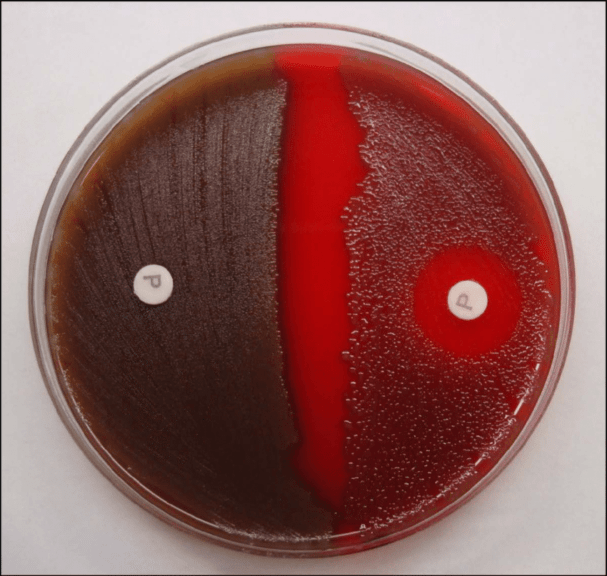
Figure 2: As noticed in the picture, Streptococcus mitis (on left) is not able to sustain its growth in the presence of the optochin, indicated by a no inhibition zone (disk) formation. On the contrary, Streptococcus pneumonia (on right) is able to sustain its growth in the presence of the optochin which can be noted by a characteristic inhibition zone (disk) formation around the bacterial colony. Image Credit: Moshtaq Talip Al-mohanna (Ref.7).
-
-
-
Magnetic susceptibility
The term susceptibility is used in electromagnetism as well. Here, susceptibility (magnetic susceptible) pertains to the measure or degree or extent to which a material can be magnetized under an externally applied magnetic force.
-
Differential susceptibility hypothesis
The term susceptibility is used in psychology as well. According to these hypotheses, susceptible individuals are “more plastic” and hence highly affected by both positive and negative environmental factors around them. On the other hand, resilient individuals are “less plastic or malleable”.
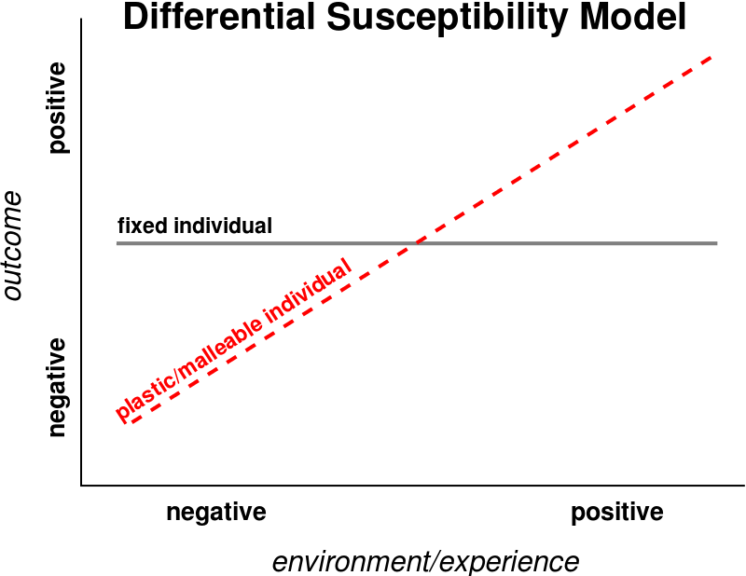
Figure 3: Representation of differential susceptibility hypothesis to show the changes in the outcomes of susceptible (plastic) and resilient (fixed) individuals. Image Credit: Snubcube.
Susceptible Examples
One of the good examples to understand the meaning of susceptible is “Susceptible Host”. This term is used in epidemiology where a susceptible host is a key member in the chain of a disease cycle or traditionally called an ‘epidemiologic triad’.
The 3 important components of this epidemiologic triad are reservoir, transmission agent, and susceptible host. The spread of the disease follows a defined chain. The infectious agent or the pathogen spreads from the reservoir. This happens via a portal of exit. The second important component of this chain is the vector or transmission agent that takes the infectious agent from the reservoir to the next host. And the third important component is the “susceptible host” in which the infectious agent enters via a portal of entry.
Many genetic and constitutional factors determine the susceptibility of a host. The immunity of an individual also plays a vital role in determining how susceptible that individual is to a given set of pathogens and diseases.
There are some common factors that have been seen to increase one’s susceptibility to various diseases. They are malnutrition, drug abuse, alcoholism, low immunity, or the prevalence of therapies that commonly impair the body’s nonspecific immune response.
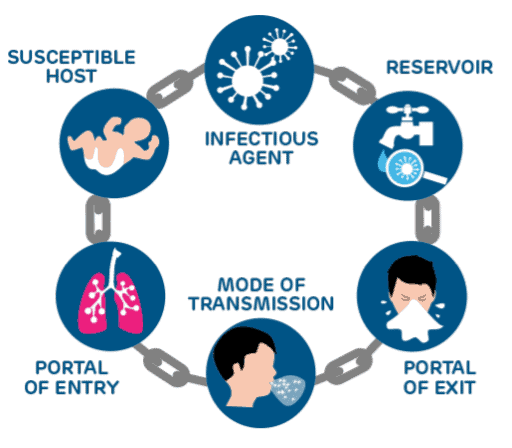
Featuring… Sickle Cell Trait
Malaria is a parasite-caused disease. By inflicting shaking chills, perturbed body behavior, and very high fever, malaria leaves one desperate once affected. The cases of malaria are very common in tropical countries of the world. As it is spread by mosquitoes (vector) it becomes irritatingly bad at times when left unnoticed and uncontrolled. But there’s one lesser-known fact that can help you and your body evade the chances of getting malaria!
That’s “Sickle Cell Trait”.
People with sickle cell trait (SCT) have been noticed to be shielded and protected (even though partially) from a particular type of malaria. Yes, you heard us right… The presence of a disease trait (not disease itself) can help our bodies in evading attacks by other disease-causing agents!!!
The particular malaria parasite against which sickle cell trait confers protection is Plasmodium falciparum. Although scientists are still trying to elucidate and thereafter decipher the mechanism by which this protective shield works, some hypotheses have been proposed. (Ref.5,6)
Some of the reasons that are still under working could be as follows:
- Maybe SCT somehow interferes with the growth of the malarial parasite in the RBCs.
- Maybe SCT somehow manages to stutter the parasite’s biologically important processes.
- Maybe SCT activates the body’s immunity when triggered by the parasite’s entry.
If you are wondering what sickle cell trait is now, it’s when a heterozygous individual inherits 1 sickle cell gene from 1st parent and another normal gene from 2nd parent. Since sickle cell anemia is a “recessive disorder”, the diseased allele won’t be able to manifest its actions until it’s in a homozygous state that outward symptoms and the disease would manifest. That’s the reason people with sickle cell trait (SCT) don’t display any symptoms of sickle cell disease (SCD) in their lifetimes.
Sickle Cell Trait vs. Malaria Susceptibility |
|
|---|---|
 |
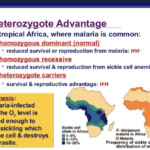 |
| Sickle cell trait vs Sickle cell disease. Source: Not alone in sickle cell. | Out of the several hypotheses, one hypothesis is pictorially depicted here. It shows how SCT can help the body in reducing the chances of getting malaria. Source: Ishanya Anthapur. |
Answer the quiz below to check what you have learned so far about the term ‘susceptible’.
References
- Khan, Z. A., Siddiqui, M. F., & Park, S. (2019). Current and Emerging Methods of Antibiotic Susceptibility Testing. Diagnostics (Basel, Switzerland), 9(2), 49. https://doi.org/10.3390/diagnostics9020049
- Kottow M. H. (2003). The vulnerable and the susceptible. Bioethics, 17(5-6), 460–471. https://doi.org/10.1111/1467-8519.00361
- Rodloff, A., Bauer, T., Ewig, S., Kujath, P., & Müller, E. (2008). Susceptible, intermediate, and resistant – the intensity of antibiotic action. Deutsches Arzteblatt international, 105(39), 657–662. https://doi.org/10.3238/arztebl.2008.0657
- Freeman, Richard; King, James; Lafyatis, Gregory (2019). “Essentials of Electricity and Magnetism”. Electromagnetic Radiation. Oxford University Press. doi:10.1093/oso/9780198726500.003.0001
- Archer, N. M., Petersen, N., Clark, M. A., Buckee, C. O., Childs, L. M., & Duraisingh, M. T. (2018). Resistance to Plasmodium falciparum in sickle cell trait erythrocytes is driven by oxygen-dependent growth inhibition. Proceedings of the National Academy of Sciences of the United States of America, 115(28), 7350–7355. https://doi.org/10.1073/pnas.1804388115
- Williams, T. N., Mwangi, T. W., Roberts, D. J., Alexander, N. D., Weatherall, D. J., Wambua, S., Kortok, M., Snow, R. W., & Marsh, K. (2005). An immune basis for malaria protection by the sickle cell trait. PLoS medicine, 2(5), e128. https://doi.org/10.1371/journal.pmed.0020128
- Moshtaq Talip Al-mohanna. (2006) Identification and Characterization of Streptococcus pneumonia. Project: Microbiological Analysis Of Commercially Prepared Yoghurt
©BiologyOnline.com. Content provided and moderated by Biology Online Editors.




